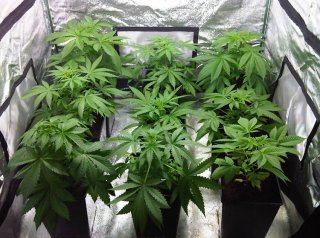Cannabis seeds are costly, aren’t they? And then there’s also the matter of shipping, especially if there are legal issues. The solution is simple. Grow the plants and produce seeds. Even if a trusted seed bank would – for some reason – run out of stock, that would be the least of your problem. In this article, we show you how to feminize seeds using methods that pros use.
Page Content
Why Feminize Seeds
In essence, this type of seed does not contain the male chromosome – at least 99% of the time. So, you could say that the plants that emerge are almost guaranteed to be females. For most of us who grow cannabis for personal consumption, we do not want even a single male to show up. And that is precisely the reason why we choose to feminized seeds as opposed to regular seeds.

As for why you should feminize seeds, there is one compelling reason. Because you can, and you can do it at home.
How To Feminized Seeds
There are two things that you need to understand when making feminized seeds.

1. Sex Chromosomes
Male plants are heterogametic, having “XY” sex chromosomes. Females, on the other hand, are homogametic with “XX” sex chromosomes.
When a male (XY) pollinates a female (XX), half of the seeds produced are males, while the other half are females.
“XY” x “XX” = either “XY” or “XX”
That being the case, if a female plant is to pollinate another female, then the resulting offspring will be a female too.
“XX” x “XX” = “XX”
2. Producing Pollens
Female plants, under normal circumstances, do not produce pollen. The key to feminizing seeds, therefore, lies in forcing the female to grow pollen sacs. And this can be achieved by using these proven methods.
The process of making feminized seeds begins with selecting the female plants. You would need at least two – one to produce the pollen, and the other to be fertilized and produce the seeds.
In nature, cannabis plants mostly produce female seeds once they are near the end of their lifetime. There is no need for more males, as only a few can fertilize a massive number of females.
Of note is ethylene – a plant hormone that is involved in numerous processes throughout the life cycle of cannabis plants. It stimulates or regulates the ripening of fruits, the opening of flowers, and the shedding of leaves. More importantly, it is also a regulator of the sex expression of plants. By reducing its level, it causes the female to develop pollen sacs.
In some literature, this process is referred to as “reversing the sex” of the plant. Technically, that is not accurate. While the plant may produce male flowers, it remains a female.
I. Rodelization Method
Rodelization uses the natural approach to altering the ethylene level. It does not entail the use of potentially harmful chemicals. Hence the ‘reversed female’ remains suitable for consumption after pollens have been collected.
In nature, when a female cannabis plant senses that it is nearing the end of its life cycle, it attempts to ensure the survival of the species by reproducing. Highly experienced growers can trick the plant by manipulating environmental conditions such as nutrients, pH, photoperiod, and temperature.
It does not have to be that complicated as there is a much simpler way – delay the harvest. After 2 to 3 weeks, the unharvested female will start to produce stamens – the male pollen sacs.
Rodelization is cost-effective as you do not have to purchase additional items, such as the chemicals used in other methods. One possible disadvantage is that this method produces fewer pollen. For home cultivation, it is more than enough but not for large-scale farming operations.
Another issue that may come up is due to its having hermaphroditic tendencies. You only need to be aware of this. If you grow plants using feminized seeds produced this way, then be more diligent in watching out for the hermies.
II. Silver Thiosulfate Solution (STS) Method
One of the most commonly used techniques is the use of STS – a solution mix of distilled water, silver nitrate, and sodium thiosulphate. Once sprayed on the female plant, it locks out the required micronutrient copper, inhibiting ethylene signaling, thus resulting in the suppression of gender expression. As a result, the plant is ‘forced’ to grow male flowers.
STS solution has a limited lifespan and should be mixed when needed. It should not be a problem, though, as the mixture is easy to prepare.
Once a plant is sprayed with STS, the only thing you can do after collecting the pollens is to discard the plant. It would no longer be suitable for consumption – not its buds nor extracts.
How To Feminize Seeds Using STS
Prepare the materials that you will need:
- Silver nitrate
- Sodium thiosulfate anhydrous or sodium thiosulfate pentahydrate
- Reverse osmosis water
- Pyrex Prepware 2-Cup glass measuring cup
- Digital scale or any precision gram scale
- Brown glass bottle with cap 500 ml (2)
- 60 cc syringe (2)
- Brown glass bottle with sprayer top 16 oz
- Stainless steel whisk
- Dawn Ultra dish soap
STS is stored as separate solutions – A & B. Here is how you prepare the solutions:
Stock Solution A: Silver Nitrate
- Pour half a liter of reverse osmosis water into a glass Pyrex Prepware 2-Cup glass measuring cup.
- Using a digital scale, measure 0.5 grams of silver nitrate crystals.
- Pour the silver nitrate into the mixing bowl slowly while stirring.
- Continue stirring until the silver nitrate dissolves into the water. It should take roughly 15 seconds.
- Pour the silver nitrate solution into a 500 ml brown glass bottle and cap.
- Label the bottle “STS A – Silver Nitrate.”
- Wash or clean the Pyrex measuring cup and anything else you used thoroughly and dry.
Stock Solution B: Sodium Thiosulfate
- Pour half a liter of reverse osmosis water into a glass Pyrex Prepware 2-Cup glass measuring cup.
- Using a digital scale, measure 2.5 grams of sodium thiosulfate anhydrous or 3.9 grams of sodium thiosulfate pentahydrate.
- Pour the sodium thiosulfate into the mixing bowl slowly while stirring.
- Continue stirring until the sodium thiosulfate dissolves into the water. It should take roughly 30 to 45 seconds.
- Pour the sodium thiosulfate solution into a 500 ml brown glass bottle and cap.
- Label the bottle “STS B – Sodium Thiosulfate.”
- Wash or clean the Pyrex measuring cup and anything else you used thoroughly and dry.
Note: For storage, you can put both bottles in the refrigerator.
Mixing For application
As a general rule, always mix A into B. In other words, the sodium thiosulfate is first poured into a sprayer bottle, before adding the silver nitrate solution.
- Use a syringe to draw 50 ml of STS Solution B – the sodium thiosulfate solution.
- Squirt into the Pyrex glass measuring cup.
- Using another syringe, draw 50 ml of STS Solution A – the silver nitrate solution.
- While whisking B solution, gently squirt solution A into the mix. This step should take around half a minute.
- Pour the STS mixture into a brown glass bottle.
- Pour 800 ml of reverse osmosis or distilled water into the bottle.
- Add 6 to 10 drops of soap.
- Cap bottle with sprayer top and shake the mixture of A and B solutions, water, and soap.
Note: You can test by spraying on a leaf to see if the STS solution would stick on a leaf without beading or rolling off. If it does, then add a drop or two of soap, shake, and try again. The 100 ml STS solution with nearly 1:9 STS to water ratio is good for use spraying a plant every 5 days for one month. For optimal shelf life, you can cover the bottles using a black plastic garbage bag for storage.
Spraying On The Female Plant
Five days before switching to the flowering period, you can start this process. After the initial spray, wait for 5 days and spray again. By the second application, you would have swapped the lamp from MH to HPS, and change the lighting schedule to 12/12. Continue spraying every 5 days.
Before spraying, cover the base of the plant with a newspaper or any suitable material. That is to keep the STS solution from reaching the root zone. It should remain there until the mixture has evaporated/dried.
The best time to spray STS on the plant is after turning off the light, marking the start of the dark cycle. Be sure to turn off the fan too.
If the plant shows signs of yellowing or burning, then you need to dilute the solution further. You can add 1/3 cup of water. If there is not enough space in the sprayer bottle, you can pour out some of the STS to make room.
III. Colloidal Silver
This solution of tiny particles of silver suspended in a liquid is often marketed as a dietary supplement with numerous health benefits. The FDA, though, has cracked down on the manufacturers for unproven claims. For cannabis growers, a solution of 30 ppm colloidal silver is invaluable for producing feminized seeds.
You could raise the difficulty level by making your own colloidal silver. But the most convenient way is to purchase, and it is widely available. Its application is also straightforward. Once the flowering period is triggered, the solution is sprayed on the female plant for up to two weeks or until male pollen sacs appear.
The colloidal silver solution should be shielded from light. Exposure causes it to degrade until it turns dark gray in color and is no longer effective in inhibiting ethylene. Like STS, plants that received this treatment are no longer suitable for consumption and should be discarded after the pollens have been collected.
How To Feminize Seeds Using Colloidal Silver
There are actually options. One is to buy a generator or make one. If you are starting out, the best option is to purchase prepared colloidal silver with at least 30 ppm.
After deciding on the female plant, all you need to do is to spray colloidal silver 1 to 2 days before triggering the flowering stage. Remember that for the next 10 to 14 days, you would want to spray on new growth and daily until male pollen sacs form. Once the male flowers emerge, it is time to separate this plant from the rest of the females to avoid accidental pollination.
IV. Gibberellic Acid Method
Gibberellins are plant hormones that play a role in the regulation of numerous processes and growth. Widely available, the most effective is gibberellic acid (GA3). Like colloidal silver, the solution – prepared with 100 ppm – is sprayed on the plant for several days before triggering the flowering stage. Besides forcing male flowers, its application also causes the treated parts of the plants to stretch significantly.
How To Feminize Seeds Using Gibberellic Acid
You can quickly obtain alcohol-soluble 90% Gibberellic Acid GA3 powder for around $10 or less. For this method to work, the concentration should be 100 ppm.
A pack of GA3 is usually 1 gram. If you were to weigh it on a gram scale, it should be around 1.11 grams, which is to compensate for 90% purity.
To have a mixture of 100 ppm, what you want to do is to maintain a 1:10 GA3-to-water ratio. You don’t want to use up the whole pack as that equates to 10 liters of water. Most of it is going to end up wasted as once mixed, it only has a shelf life of 1 week.
So, what you can do is to start off with 0.1 grams mixed into 1 liter of water. You can spray it on the female plant daily for 10 days. If needed, you can always make a new GA3 solution.
How To Collect The Pollen And Store
How do you know when to collect pollen? When you notice that the pollen sacs are just beginning to open up, then you know this is the right time as it is most viable at this point.
What you can do is to remove an entire cluster and store it in a sealed container for a few days. Once dried, place it on top of a micron sheet with wax or parchment paper beneath. Shake the cluster, and the pollen will separate and drop through the filter and onto the paper.
Once done, you can add flour to the pollen at 4:1 flour-to-pollen ratio. The reason for that is to prevent moisture, which is damaging to the pollen.

Wrap the paper and place inside an air-tight container, preferably with a dark color to help prevent exposure to light – for example, a film canister or brown medicine bottle. It should be as small as possible to reduce the amount of oxygen that can degrade the pollen. One way to do that is to reduce the free air volume by adding uncooked rice. It also helps reduce moisture.
You can now place the collected pollen for long-term storage in the refrigerator or freezer. As much as possible, the temperature should remain consistent without much fluctuation.
How To Pollinate
Once the selected mother plant is already 2 to 3 weeks into the flowering stage, it is ready to be pollinated.
Use a small paintbrush with soft hai to lather the pollen you have collected onto the buds and the branches. It is up to you to pollinate the entire plant or only some of the buds.
It takes up to six weeks for the mother plant to develop seeds fully. During this time, ensure that you are providing optimal nutrients and atmospheric conditions.
Note: You also have the option of putting the reversed female and the female plants together and let nature take its course. For that to happen, you have to work on the timing. The idea is to have the reversed plant release pollen when the mother is 2 to 3 weeks into flowering.
How To Harvest Feminized Seeds
A mature seed should have a dark brown or tan color. Most would also have tiger stripes. Collecting the seeds is easy, you simply remove the buds and dry, then crush to free up the seeds.

It Keeps Getting Better
As it turns out, it is not complicated to make your feminized seeds at home. Essentially, what you are doing is to force a female plant to produce pollen, which is used to fertilize another female. The seeds produced, a product of crossing two XX chromosomes is XX – a female.
You can choose to do it naturally, using the rodelization method. Or, you can do it like what many seed banks do, use chemicals. Most home growers opt for STS or colloidal silver.
If you feel unsure, then you are no different from all tworld ‘sd’s top breeders. At one time in their younger years, all of them also experienced the same apprehensions. They only became skilled because rather than merely read, they put the theoretical knowledge into action.
So, what are you waiting for?





